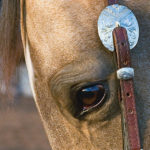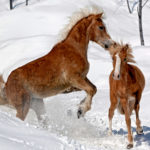3 August 2012
http://www.youtube.com/watch?v=jXgVVIBd0lc “Look beyond you turn!” “Don’t look down!” “Where are your eyes?” If it’s not your leg, it’s your hands, your seat, your shoulders…and when your trainer can’t find anything else wrong, you can be sure your eyes are looking somewhere they shouldn’t. Maybe your instructors have been right all these years. Where you look is where your horse is going to go, even if it’s up and over a five-foot vertical on the Olympic jumping course at the London 2012 Olympics. But what if it’s not so much where you look, but how you look? Your trainer might be chagrined to find out that top riders have rapid and tiny eye movements that you can’t see across the arena. In fact, it took scientists with special mini cameras to figure it all out. The “equestrian vision” research at Nottingham Trent University is an example of equestrian science hard at work to understand how top riders do that they do. Many are not able to articulate their skills and movements in the saddle, but the technology used on a tennis player or a baseball pitcher can be applied to riders. What it comes down to is excelling at hand-eye coordination. That said, we all know it is more than that, since a rider’s hand-eye coordination doesn’t guarantee him or her success at ping pong or golf. ?There are other subtle factors at work, and research tells us that eye movement is all part of it. But no one had recorded an elite rider’s eye movement until British sports scientists attached little cameras to former Olympian Tim Stockdale. What researchers did acknowledge is that elite athletes use their eyes differently from the rest of us. Three factors vary:?the way the direct their gaze, the way they make predictive eye movements and the fact that they focus on important relevant features for longer than non-elite athletes. In show jumping, these visual strategies come to the fore as the horse approaches a jump. The rider must see the ideal take-off point for the jump ahead and collect the horse to reach that point at the optimum split-second. Using their high-tech mobile eye-tracking device, the Nottingham Trent University team has been able to record exactly what a rider looks at — and measure for how long — when approaching a jump. A glasses-mounted camera unit is able to monitor the minute movements of the rider’s eye. Software then overlays those movements onto a video of where the rider is facing. When played back, the footage shows a red circle to depict exactly what the rider was looking at, frame by frame, during the approach to a jump. The study?tested a show-jumper, an event rider, a point-to-point rider and a non-competitive rider. Each of the riders was asked to make five rounds of an identical three-jump course, with each round recorded by the mobile eye tracking device. By playing back the footage, the researchers were able to monitor the rider’s point of gaze at each stage of the course and determine how long they spent looking at specific areas or features. Preliminary analysis revealed that when approaching a jump, riders rapidly alter their point of gaze from the ground in front of a jump, to the jump itself, and then to the ground beyond. However, the more experienced show jump rider was found to fix his gaze on the jump much sooner than each of the other riders — up to 3.05 seconds earlier before takeoff than the least experienced non-competitive rider. The top rider also spent significantly longer fixated on each point. Tim Stockdale, Olympic show jumper and honorary graduate of Nottingham Trent University, felt it was critical that eye movement be studied, and that developing riders have their eye movements evaluated as their training progresses. This research makes head cams almost seem passe. Imagine if we could see not where competition riders are going, but what their eyes are actually doing. Research might also look into riders who wear glasses, such as Canada’s Ian Millar, and see if corrective lens can be effectively fitted into a helmet visor or integrating equipment on the rider’s head into one unit. Riders will always have to worry about their legs, heels, hands, seat, shoulders, elbows, wrists and chins. But imagine what this research could do if it is expanded to help disabled riders, sight-impaired riders or therapeutic riding trainers. Bonding the world’s neediest riders with the most elite is a connection that needs to be made more often, as we look to improving the future of horse sports on levels far beyond the Olympics.







